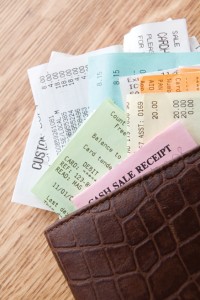CATALOG IT!: How to Create a Home Inventory
 After disaster strikes, the last thing homeowners want to worry about is trying to determine the worth of their stolen or damaged property. It’s probably safe to say that most homeowners have a difficult time providing their insurance companies with an accurate estimate of their losses in the event of a major happening, like a severe storm or even a burglary. Taking a room-by-room inventory of your home is one of the most undervalued tasks that homeowners face. It seems to be one of those things that everyone agrees is a great idea, but rarely takes the time to do. We shouldn’t think, “It can’t happen to me,” as no one is impervious to such events. Furthermore, a room-by-room inventory can provide a valuable opportunity to re-evaluate your homeowner’s policy. Once you understand the importance of creating a home inventory and see how easy the process can be, the task becomes less daunting, and you’ll be left feeling prepared for any event.
After disaster strikes, the last thing homeowners want to worry about is trying to determine the worth of their stolen or damaged property. It’s probably safe to say that most homeowners have a difficult time providing their insurance companies with an accurate estimate of their losses in the event of a major happening, like a severe storm or even a burglary. Taking a room-by-room inventory of your home is one of the most undervalued tasks that homeowners face. It seems to be one of those things that everyone agrees is a great idea, but rarely takes the time to do. We shouldn’t think, “It can’t happen to me,” as no one is impervious to such events. Furthermore, a room-by-room inventory can provide a valuable opportunity to re-evaluate your homeowner’s policy. Once you understand the importance of creating a home inventory and see how easy the process can be, the task becomes less daunting, and you’ll be left feeling prepared for any event.
 Take it All In
Take it All In
Start by making a room-by-room list of all of your possessions. Begin with the more valuable items that jump out as important. Working from general to specific is the way to tackle this task. You may even be able to do most of the first pass at your list off the top of your head. Furniture, appliances and electronics are obvious items you should include; from there, move on to the smaller items that surround them. At this point you are simply capturing a list, whether with pen and paper, or a voice recording, or a simple electronic file. For this phase, you’ll want to physically be in the room you’re inventorying so that you don’t miss things such as rugs, lamps and décor. Be sure to include built-in features, such as light fixtures. While you don’t need to include every item in your home down to the last paperclip, it is better to be overcautious here; if anything is questionable, just include it.
 Get the Complete Picture
Get the Complete Picture
Once you have this preliminary list, it’s time to get creative with how you’ll catalog the items thoroughly. The key things you want include for each item are a photo or video, a detailed description including when and where it was purchased if possible, a serial and model number if applicable (especially important for electronics), a receipt if you have it, and most importantly, an estimated value of the item.
Even a basic handwritten compilation is job well done, but considering you are going to be dealing with a reasonably long list with pictures or video, you may decide to go a more technical route and create an Excel spreadsheet, PowerPoint slideshow, or use a specialty program or web application. You may even choose to create a video recording of some sort; the benefit of this is that you can include your own narration and description of your items as you are filming. You may as well have fun with it, because experts suggest that insurance companies don’t prefer one type of media over another.
There are many websites, applications and software programs that are designed to keep track of your entire home inventory. Some online sites even offer web-based storage of your data, and some are free. (One example is Know Your Stuff®/Home Inventory (www.knowyourstuff.org), a free browser-based software produced by the Insurance Information Institute. It contains all the forms and documents you need to take a room-by-room inventory and allows you to save this information to their secure online storage.) It is always a good idea when dealing with computer or web storage, however, to create a hard copy of all documents.
 What’s it Worth?
What’s it Worth?
You may find that the most challenging step is estimating the worth of your valuables. When assessing your belongings, it is crucial to distance yourself from personal or emotional attachment. While it may be difficult, try to focus on the facts to create a distinction between the “value” and the “worth” of your possessions. While your great-great-grandmother’s wedding ring might hold tremendous value to the family, it unfortunately may not be worth as much to an insurance company. Because insurance companies have the final say when it comes to claims, it is better to work out the value of precious items with an insurance appraiser before such items are destroyed or lost.
While estimating the value and determining if certain things are fit for including in your inventory, keep in mind that you can group like items. It’ll be easier, for example, to group possessions such as dining and flatware, pots and pans, china sets, clothing, toiletries, books, collections of DVDs, games and music, and even food and spices. For bigger ticket items such as musical instruments, designer clothing and expensive jewelry, it is highly recommended to do some extra research on these particular items for a more accurate estimate. There are many calculators online that can help give you a good idea of the overall worth of your home inventory. The more efficient you are in your estimates now, the less you will have to worry about later.
 Keep it Safe
Keep it Safe
After you have finished taking inventory, it is extremely important to make a backup version of your list and keep it somewhere safe that is NOT in your home. Consider stashing an additional copy somewhere like a safety deposit box, in the hands of a trusted friend or relative, and/or using online cloud storage. It won’t help much if your only documented inventory ends up being destroyed along with the items it was created to protect!
Not only will having a home inventory list on hand make resolving disastrous situations much quicker, but your insurance company will be easier to work with and is more likely to accept your claims. Not to mention that after creating your inventory list, you might even realize that your homeowner’s insurance policy needs to be re-evaluated based on this newly obtained data.
A final and ongoing step in this process is to keep your inventory list updated. It is easy to forget how often we add new belongings to our home. Once you have the list in place, updating it should be quick and painless. While you may not have worried much about having an inventory list in the first place, a new peace of mind will be had after creating one. Of course there are going to be sentimental items that you cannot put a price on and will never be replaceable—but for everything else, you can rest easy knowing that if disaster strikes, you are taking the necessary steps to remedy the situation before it even occurs.
House Inventory, Insurance Claims, Picture Catalog, Records of Possessions, Replacement Cost, Safe Inventory, Valuables Worth






